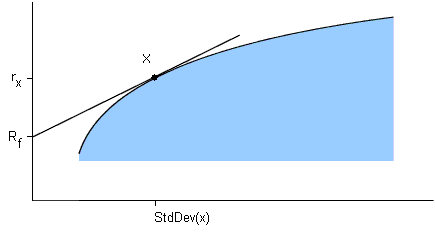Patrick said:
Thanks for that, Alec. So we want the portfolio with the highest ratio? ESRBob, in his book "Work Less, Live More" shows what he calls Alpha, which is a percentage that a particular portfolio is better than the index, i.e., one portfolio has an Alpha of 6%, meaning that it did 6% better than the S&P 500 on a risk-adjusted basis. Is this the same Alpha that stock analysts use?
Yes, if all you're concerned about is returns vs. standard deviation, then the higher the sharpe ratio the "more utility" [i.e. higher level of happiness/satisfaction] you'll get. If you look at the attached picture below, the sharpe ratio is simply the slope [i.e. rise/run] of the line that goes from the risk free rate [Rf] to a portfolio located on the efficient frontier [X]. The portfolio that is touched when the line become tangent to the efficient frontier [or "tangency portfolio" or "X"] gives the highest slope of the line, and thus the highest sharpe ratio.
The next step is to mix some of the risk free asset [Rf] with the mix of risky portfolio ["X"], which may contain stocks and bonds, to satisfy your risk tolerance. So, for example, really risk averse investors could choose to invest 80% in Rf and only 20% in X. That's the theory anyway.
Note, however that this portfolio may not give you enough return to enable you to meet your savings/spending goal [as Brewer pointed out].
No, I think that Bob was not using the typicaly definition of alpha that stock analysts use. I think Bob was more or less saying by being more diversified than the S&P 500 [with a small value tilt, adding int'l, etc.], you got a higher return for the same risk.
Alpha is usually defined as the extra return that a manager adds that cannot be explained by the fund's exposure to various risk factors. In the case of the Capital Asset Pricing Model [CAPM], there is only market risk, but in Fama&French's 3 factor model there are also risks associated with value stocks and small stocks.
Normally, when one calculates alpha, one does a statistical regression to see if there is any extra return that cannot be explained by some explanatory variable. In the case of CAPM, it is the return of the market [i.e. TSM or S&P 500] minus the return of some risk free asset [Tbills]. In F&F 3 factor model, there are two other explanatory variables that when added can better explain the returns of diversified stock portfolios: the so called "value factor" (HML - High minus low) and "small factor" (SMB - small minus big).
Anyway, back to beating the S&P 500 on a risk adjusted basis. There are a number of ways to calculate risk adjusted returns. One way I've seen is to use:
[(ave return of portfolio) – (ave return of Tbill)]*[(SD of index)/(SD of portfolio)] + ave return of Tbill
For example, the risk adjusted return of a portfolio invested in 1/3 LBA, S&P 500, and EAFE vs. the S&P 500 alone is around 14%, which is higher than the average return of the S&P 500. Both this and the sharpe ratio are just another way of saying, "You get more return per unit of risk compared to "X"."
Of course, one should always ask why the sharpe ratio is higher or the risk adjusted return is higher. The reason is that with slice and dice portfolios like in Bob's book, or Coffeehouse, etc., you're usually adding asset classes that are not highly correlated with each other. Also, the slice and dice portfolios include more small cap stocks and more value stocks than are in the S&P 500, and since small and value have had higher returns than the S&P 500, the slice and dice portfolios have performed better. However, most of the slice and dice portfolios have the same standard deviation or less than the S&P 500 with a higher return. Hence free lunch, unless of course one believes Fama&French that small and value are actually riskier. But, I wouldn't call this alpha since the extra return is due mostly to tilting towards small and value.
- Alec
modified at 1:46 on 11/2/06

